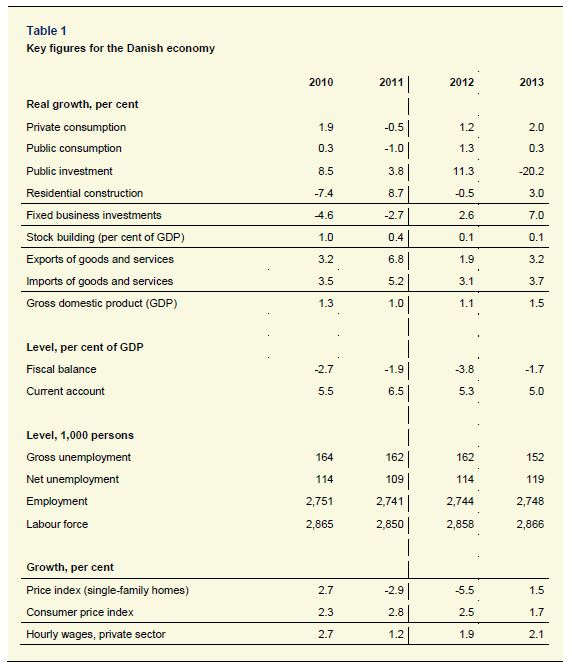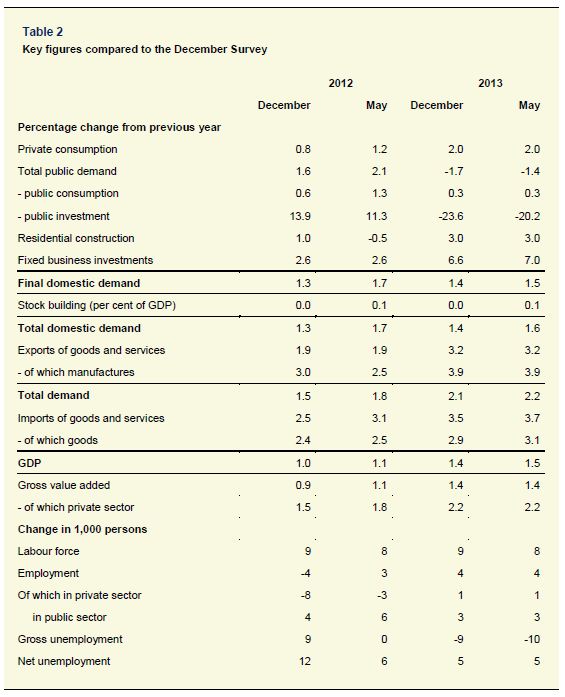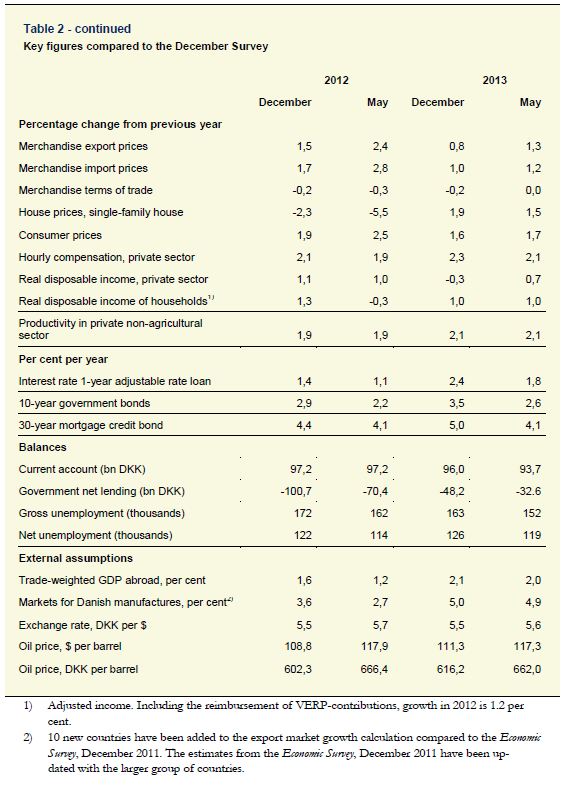25-05-2012Denmark benefits from being considered a ”safe haven” among investors and interest rates are currently at a historical low. Combined with the Government’s “kick-start”-package, the reimbursement of contributions to Voluntary Early Retirement Pension (VERP) and improved confidence among consumers this gives reason to expect modest growth in GDP in the rest of this year and in 2013. However, the outlook is subject to considerable uncertainty due to current events in the euro area. These are key messages in the Economic Survey, published today by the Ministry of Economic Affairs and the Interior.
Overall, the Danish economy is gradually improving at a slow pace, although the repercussions of the financial crisis in 2008 are still weighing on the growth prospects. GDP is estimated to grow by 1.1 per cent this year and 1.5 per cent next year. Due to high confidence in the economic policy, interest rates have dropped to an extraordinary low level this spring. The fall in interest rates since 2008 implies, all else equal, a level of GDP that is just over 2.5 per cent higher in 2013 and 45,000 persons more in employment.
Sound public finances and continued confidence in the economic policy is essential in order to ensure that Denmark can continue to benefit from low interest rates. The Government's economic policy, including the reforms in the 2020 Plan, the Budget for 2012 and the agreement on a Budget Law, is planned within that context. The general objective is to maintain a responsible and credible economic policy that supports growth and employment.
These key messages are further elaborated in the Economic Survey published today.
The Minister for Economic Affairs and the Interior, Margrethe Vestager, says:
It is a key priority for the Government to pursue a credible and responsible economic policy, which underpins confidence in the Danish economy. This is evident in the Government Platform, in our 2020 Plan and in the reform proposals that are currently under implementation. We now see the results from this policy – in the form of low interest rates supporting employment. Although Denmark is still affected by the crisis in the international economy, I am happy to see that the Danish economy is improving. It is still not satisfactory – but we are moving forward.Margrethe Vestager
Main messages in the Economic Survey
- The economic policy supports activity in the Danish economy significantly. Despite the effects from the international downturn, GDP is expected to grow by 1.1 per cent this year and by 1.5 per cent next year due to very low interest rates, the Government’s “kick-start” package, the reimbursement of VERP contributions and a strong improvement in consumer confidence.
- Growth is primarily driven by consumption and investments in the private sector, but positive contributions are also coming from public demand. Only limited contributions are expected from exports this year, while next year exports are one of the main drivers behind growth, implying that growth becomes more self-sustained.
- The growth in production is not strong enough to improve conditions in the labour market significantly. Employment is expected to increase slowly by 3-4,000 persons this year and again next year. Gross unemployment has continued on a stabile path in spring 2012 and is expected at 162,000 persons on average this year – which is the same level as last year. Gross unemployment is expected to fall from this autumn and an average level of 152,000 persons is projected for 2013.
- The public finance deficit is expected at just over DKK 70 bn. (just under 3.8 per cent of GDP) this year, compared to just under DKK 35 bn. (1.9 per cent of GDP) last year. This year, the deficit is affected by the one-off reimbursement of VERP-contributions corresponding to 1 per cent of GDP. In 2013 the deficit is expected to be reduced to DKK 32½ bn. (1,7 per cent of GDP) and the structural balance is expected to be in balance. Thus Denmark will fulfil the EU recommendation of consolidating public finances by 1.5 per cent of GDP from 2010 to 2013 and bringing the deficit below 3 per cent of GDP in 2013.
- The forecast for the Danish economy is based on a modest improvement in the outlook for the international economy since the turn of the year, where the situation was marked by exceptionally high uncertainty. A number of international initiatives were launched in order to stem the crisis, including the longer term refinance operations (LTRO) from the European Central Bank (ECB) and the adoption of a new framework for strengthened fiscal policy in the EU. In the beginning of 2012 confidence and equity markets strengthened and world trade picked up.
- Considerable uncertainties remain regarding the strength of the recovery in the international economy, and especially in the Euro area. The immediate effects of the ECB’s new lending facilities may be petering out, and confidence and equity markets in the euro area have been decreasing lately. The forecast is based on an assumption that financial market turmoil will not flare up and that the debt and confidence crisis in the European economy does not escalate.
Annex:
Table 1: Key figures for the Danish economy
Table 2: Key figures compared to the December Survey


